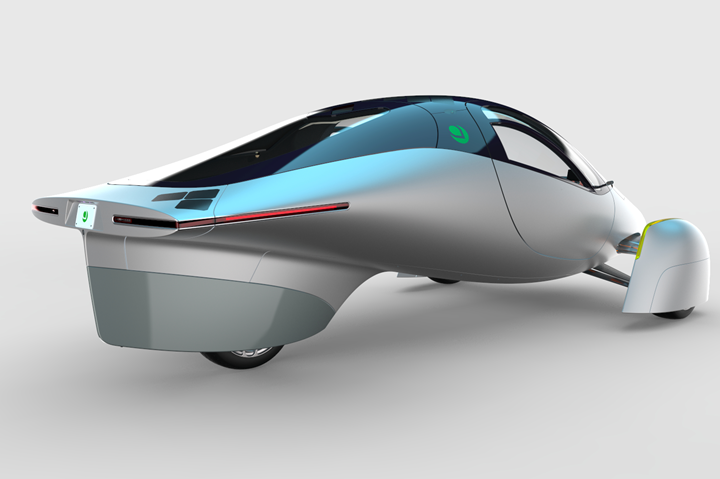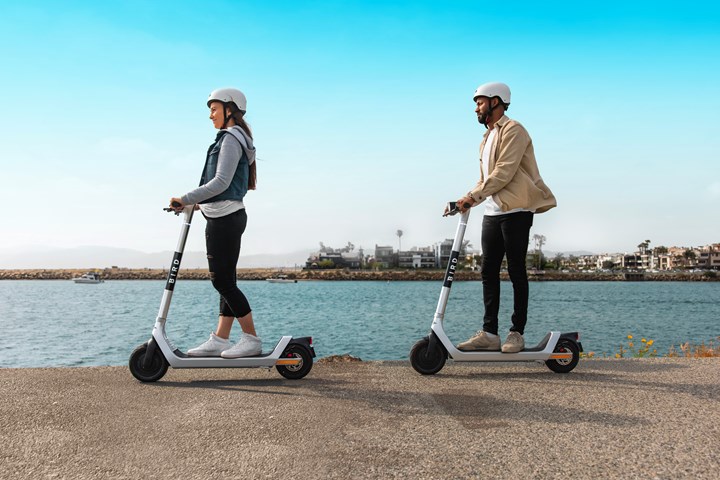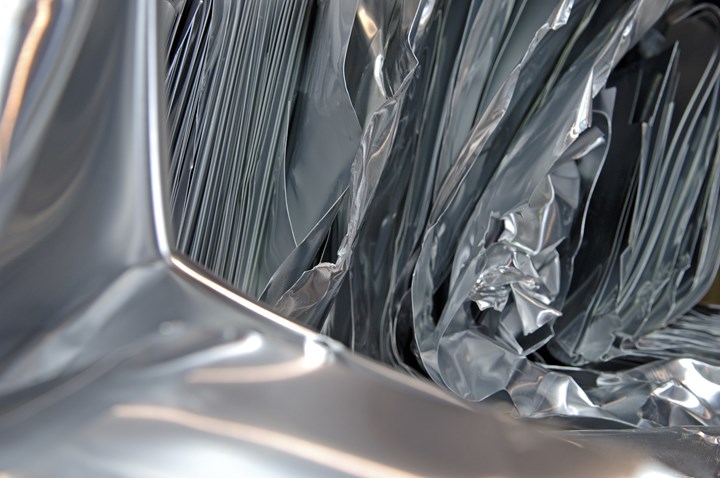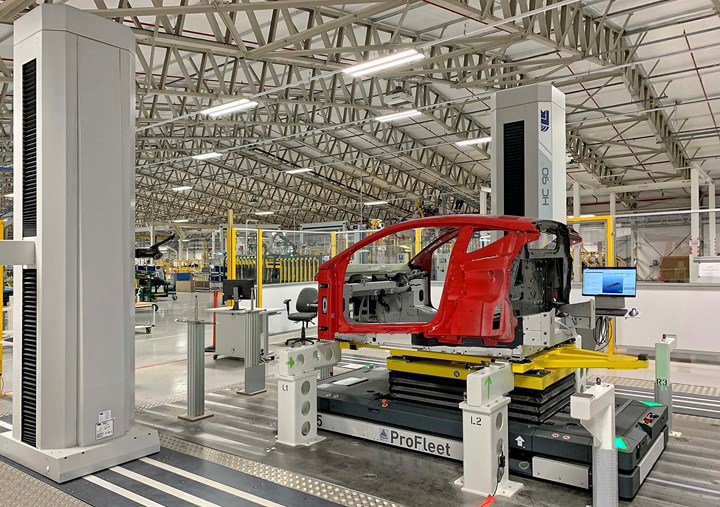on Atypical (for most of us) Modes of Transportation
A (partially) sun-powered vehicle. . .Bentley’s three-car collection. . .minimobility. . .a quick four-wheeler. . .scooter LCA. . .Porsche aluminum recycling. . .Lotus metrology. . .Christmas car. . .
About Aptera

Three wheels. Seating for two. Solar cells to help charge the electric motor. And real. (Image: Aptera)
When you think about electric vehicles, chances are it is something that has four wheels, and if you think further, two (e.g., bike; scooter).
But Aptera is preparing to launch the, well, Aptera (the company and vehicle name are the same), which has three wheels. Either two or three of them are each powered by 67-hp wheel motors.
It also has a rather. . .distinctive body architecture, an aerodynamic pod that can handle two passengers and 25-cubic feet of cargo.
On the aero: the company says the coefficient of drag is just 0.13, and while it compares that to more conventionally configured vehicles (e.g., the Tesla Model 3 with a 0.23 Cd, ), the vehicle is technically classified as an “auto-cycle.”
The Aptera can be selected with one of four battery packs that provide a range of from 250 miles to 1,000 miles.
It is using 21700 NMC 811 cylindrical cells from EVE Energy Co. in the structural battery packs it is assembling in San Diego.
Sunshine Power
But one of the most intriguing aspects of this composite-intensive vehicle is that it features solar cells that provide measurable amounts of range.
The base model comes with solar cells on the roof and dash that are sufficient to provide 16 miles of range after eight hours of charging.*
For an additional $900 (the base MSRP is $25,900), there are solar panels added to the hood and hatch (~700 W of solar cells). This provides a 40-mile range over eight hours of charging.
Typically solar panels are flat.
So among the challenges that developing the solar cells for the vehicle (in addition to being able to withstand typical automotive demands ranging from temperature extremes to impact from debris) was getting them to be 2D, or more simply, curved.
Which they’ve accomplished. (You wouldn’t get that coefficient of drag with a bunch of flat solar panels attached to the exterior.)
Aptera is using Gen 3 cells from Maxeon Solar Technologies. The companies have announced that the cells are being produced in a 130,000-square foot manufacturing facility in Vista, California, not far (~10 miles) from the Aptera final assembly operation in Carlsbad.
Some Insights
To get some insights into the Aptera vehicle, we talked with Sandy Munro, CEO of Munro & Associates. His firm has been working with Aptera on the design, engineering and manufacturability of the vehicle.
Asked about the rationale behind the use of composites (strength? safety?), Munro says a key driver was the aero: “We wanted the best aero we could possibility get, and we couldn’t do it with stamped aluminum and certainly not stamped steel.”
Another aspect: because of the repeatability of making the carbon fiber components, there is build consistency. There are four primary components that make up the vehicle body; they are glued together.
As for the design, Munro says that not only is it highly stable on the road (“I tried my utmost to flip it over—and I know how to tip over a car”), but it has sizeable crush zones front and rear, and the front wheel configuration is such that in a small-offset collision a wheel would be torn off, not go into the cabin.
But three wheels. . . ?
Munro points out there are literally millions of three-wheelers in India and China, so while four wheels are dominant in the West, he thinks that the benefits of the Aptera—such as that ability to operate it for nothing thanks to the solar charging—will make it an iconic vehicle.
Munro, who is not given to hyperbole, thinks the Aptera will become an “iconic vehicle,” something that may be thought of along with the Model T, Beetle and MINI.
Why?
Because, he answers, those three vehicles—and he believes the same of the Aptera—have these things is common:
- Inexpensive to buy and operate
- Feature a unique shape
- Are simultaneously utilitarian and cutting edge
Plans call for Aptera to go into full-scale production next year and initial deliveries before the end of 2023.
--
*The Aptera website has a feature that allows you to select the geographic “sun zone” you live in and indicate the number of miles per day that you travel. It calculates the amount of charging that would be required for a year based on those inputs. Obviously, someone who lives in Palm Springs is going to be doing a lot less charging than someone who lives in Anchorage.
>>>
Color Me Surprised

The Bentley Beverly Hills Collection. The entire collection. (Image: Bentley)
Some numbers related to Bentley:
- The Continental GTC Speed has a W12 engine.
- It produces 650 hp.
- It propels the car 0 to 60 mph in 3.6 seconds.
- The car has a top speed of 208 mph.
- Mulliner, which is now Bentley’s in-house personal commission division, was founded in 1760. It provided coaches for the Royal Mail back then.
- Henry Jervis Mulliner initiated ties with Bentley in 1923 when his firm did coachwork for a Bentley 3 Litre that was displayed at the Olympia Motor Show.
And then there’s this, which is the real kicker:
- Three. That’s the number of Continental GT W12 Speed Convertibles that were built for the Beverly Hills collection.
Why Is This Interesting?
Each of those three cars, specialized by Mulliner, is painted a different pastel color: Jetstream II blue; Sage Green; Hollywood Blush pink.
Somehow that is to evoke upscale L.A.
Each Continental is hand-sprayed at the Bentley factory in Crewe.
Yes, the entire collection consists of just three cars.
Exclusive.
>>>
Beyond (or Below) Micromobility
Minimobility could blow up. In a good way.
So indicate some McKinsey analysts who obtained data from a survey of 26,000 people in eight countries.
The more commonly heard “micromobililty” consists of things like e-bikes, mopeds and e-kickscooters.
Minimobility is about three- or four-wheeled vehicles that seat no more than two, have a curb weight between 220 and 1,100 pounds and have maximum speed of 15.5 to 56 mph.
While this might seem to be something of small interest, according to McKinsey it could reach (depending, of course, on increased interest) a total addressable market of $100-billion annually by 2030 across China, Europe and North America.
Why might this happen?
- For consumers the vehicles are easier to park.
- For manufacturers the vehicles are easier to build and require fewer resources (especially in the battery category).
- For pedestrians and micromobility users the mini vehicles are safer because of comparatively low speeds and sufficient size to make them visible.
As is not unusual in large surveys, there are some unusual findings.
Demographics: 20% of those between ages 18 and 29 would consider minimobility. 46% between 30 and 49 would. (Perhaps that younger cohort thinks it is going to get a 3 Series and the slightly older ones know how that works out.)
Use case: Overall, 48% said the primary use would be grocery shopping. Leisure activities and commuting follow, at 36% and 31%, respectively. But in China and the U.S. the grocery shopping number was down about 12% below the global average. (Maybe this explains, in the U.S. at least, the popularity of full-size SUVs and pickup trucks: lots of groceries.)
Other vehicles: Of those who are interested, some 35% own a premium car. 31% own vehicles in the entry and volume segments. (Perhaps the premium vehicle owners have more disposable income for a second vehicle, even if that vehicle is a minimobility unit.)
But then there’s this.
The survey shows that while 57% of those surveyed in China are “likely” to use minimobility as part of their mobility mix, almost as many—56%--in the U.S. say “not likely.”
While this may be thought that this is predicated on those in the U.S. being somewhat, well, generally interested in comfort in their transportation options, McKinsey found that 66% of the Germans surveyed said that minimobility is “not likely” to be part of their mobility mix.
>>>
Beyond a Conventional Scooter

Carbon-fiber deck. Two electric motors. Independent suspension setup. (Image: D-Fly Group)
While on the subject of alternative mobility. . .
There is a new vehicle that will be coming out of the UK in December*, a “Hyperscooter.”
It’s called the “Dragonfly.”
It is like a scooter, as there is a deck (fabricated with carbon fiber, aluminum and a magnesium alloy), but rather than having two wheels it has four 10-inch pneumatic tires.
What’s more, it has a double wishbone suspension and hydraulically damped springs on all four wheels. The scooter has what is called a “3-Dimensional Full-Tilt Steering System,” which allows the driver to take advantage of the suspension setup while maneuvering the vehicle through turns and terrain.
There are two 550-W motors powered by Samsung 21700 50E batteries. The removable 20-Wh battery pack is removable. It charges from 0 to 70% in under two hours and can go to 100% in about three.
The Dragonfly has a top speed of 25 mph going forward and 3 mph in reverse. The range is up to 50 miles.
There are two mechanical rear drum brakes and two electric brakes for the front wheels.
The curb weight is 40 pounds and it folds so that it can be carried and stuck under a desk; in folded form it takes up 2.7 square feet. It can handle a load of 350 pounds.
There are two versions, the DF for urban riding and DFX for off-road (with this adding a bit more in the way of cladding on the front of the tiller to protect the driver).
Why Does This Exist?
Jez Williman, the CEO of D-Fly Group, had been a tri-athlete until he underwent substantial knee surgery. After months in a wheel chair and then on crutches, he found that using a foot-powered scooter was a better—but insufficient—approach to mobility.
Early on in their existence he bought and analyzed an array of e-scooters. Williman found them lacking.
Then he tried skateboards and realized that that was not going to be a particularly safe approach.
So he and his team began to develop what was to become the Dragonfly.
--
*Its Indegogo campaign has surpassed its goal with some days to go, so funding should not be an issue for launch.
>>>
Bird Conducts an LCA

Riding the Bird Three provides comparative environmental benefits a LCA shows. (Image: Bird)
And while on the subject of scooters. . .
All things being equal, it might seem as though an e-scooter is relatively environmentally benign.
But Bird Global wants to underscore that:
It conducted a life-cycle analysis (LCA) for its Bird Three e-scooter.
The analysis takes into account not only the manufacturing and assembly of the scooter, but the production of replacement components, as well.
The LCA had participation by EarthShift Global, a third-party ISO expert, to assure that the LCA is consistent with ISO standards. The LCA emissions model developed for Bird was reviewed and documented by Ramboll, a Danish engineering and consulting company.
(There is a European focus to this undertaking.)
“Bird’s LCA sets a new industry standard for emissions reporting quality, enabling reliable comparisons across European modes and vehicles, and helping Bird to identify and reduce emissions wherever possible.”--Shane Torchiana, CEO, Bird
The lifespan of the scooter is considered to be five years.
Torchiana noted that the company’s LCA has two other rationales:
- Other micromobility providers. This “is a call to action for all other operators to follow the same standard so that together, we can address misconceptions around vehicle life cycles.”
- Municipalities. If others join Bird in providing the environmental benefits of riding an e-scooter rather than taking other modes of transportation (e.g., in the Bird Three case, there are 21% fewer greenhouse gas emissions per kilometer than taking the metro), they can help “educate our city stakeholders with the information they need to make informed decisions when selecting a responsible micromobility partner.”
Aluminum Stamping and Recycling

Aluminum scrap like this will be used to make new sheet, which will be used to produce new parts. (Image: Novelis)
And one more thing with environmental implications. . .
Smart Press Shop (SPS) is a joint venture between Porsche AG and Schuler Group.
Yes, the OEM and a supplier of pressworking equipment have opened a factory in Halle (Saale), Germany, where body panels and parts are produced in limited volumes with both aluminum and steel in an Industry 4.0 environment.
While Porsche is a customer for the stampings, SPS plans to expand to other OEMs.
About Its Aluminum
SPS is collaborating with aluminum supplier Novelis on a closed-loop recycling system.
Novelis supplies flat-rolled products from its facility in Nachterstedt, Germany, which is about an hour’s drive from Halle (Salle), to SPS.
Aluminum scrap is shipped back to Nachterstedt, where it is turned into rolled sheet that is then sent to SPS. . .
Novelis says that recycling aluminum requires 95% less energy than is required to produce primary material. Consequently, the Novelis-SPS arrangement will reduce carbon emissions by as much as 100,000 tons annually.
Why Does This Matter?
"High-end car customers have a clear vision of what they expect manufacturers to provide, and in addition to premium quality, sustainability is playing an increasing role."--Hendrik Rothe, Managing Director of SPS.
Green creds matter in the market.
>>>
Measuring the Lotus Emira

Measuring the Lotus Emira at the plant in Hethel. (Image: LK)
Lotus Cars is producing its last internal-combustion car, the Emira, in its plant in Hethel, UK. To assure build quality of the car—as well as those that follow in the factory—it installed an automated, multi-sensor inspection cell. It is based on an LK Metrology HC-90TR dual horizontal arm coordinate measuring machine (CMM). There are Nikon XC65DX-LS laser scanners affixed to infinitely adjustable Renishaw PHS-2 two-axis CNC wrists on the CMM arms.
Each Emira goes through the measuring cell—which has a measuring volume of 6.3 x 1.6 x 2.5 meters, so it can accommodate a vehicle—twice: once at the end of the framing line and after it is fully assembled.
In case you’re wondering: the first edition Lotus Emira will arrive in the U.S. in Q2 2023. The starting price is $93,000.
>>>
Get Ready for Christmas

This scale model Testa Rossa can be a very special Christmas present. Very special. (Image: The Little Car Company)
Last year we wrote about a potential Christmas present, the Bugatti Baby II, a ¾-scale Type 35 that was on sale at Harrods in London.
As it was posted just a little over a week before Christmas, probably many of you were disappointed you didn’t have the opportunity to get this downsized EV for your children or grandchildren.
So as a public service, well before the big day, know that this year at Selfridges on Oxford Street there is the Ferrari Testa Rossa J on display, another ¾-scale vehicle crafted by The Little Car Company, this in cooperation with Ferrari.
Little But Credible
The Testa Rossa J has a hand-formed aluminum body, a steering wheel from Nardi (which supplied the non-J 250 Testa Rossa), and even tires from Pirelli.
There are four driving modes:
- Novice: 15 mph
- Comfort: 25 mph
- Sport: 50 mph
- Race: 50 mph
(Although Sport and Race have the same top speed, Sport is 10 kW and Race 12 kW, so there is more zip to the latter. Still: 50 mph?)
The Testa Rossa J has a range of about 56 miles.
Production is limited to 299 vehicles.
Starting MSRP: €92,000 excluding VAT and delivery.
You’ve been informed early enough for Christmas.
\\\
RELATED CONTENT
-
On Electric Pickups, Flying Taxis, and Auto Industry Transformation
Ford goes for vertical integration, DENSO and Honeywell take to the skies, how suppliers feel about their customers, how vehicle customers feel about shopping, and insights from a software exec
-
Rage Against the Machine
There have been more than 20 reported attacks against Waymo’s self-driving fleet in Chandler, Ariz., since the company began testing the technology on public roads there two years ago.
-
Apple Reports its First Fender-Bender with Autonomous Car
Apple Inc. reports that one of its self-driving cars operating in autonomous mode was struck by another vehicle while inching into freeway traffic in California.


.jpg;width=70;height=70;mode=crop)






